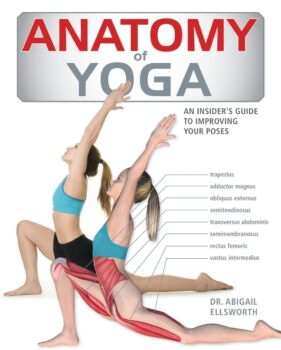The Anatomy of Yoga by Dr. Abigail Ellsworth is a must-have resource for anyone looking to deepen their understanding of how the body works in yoga. This book bridges the gap between the art of yoga and the science of anatomy, providing clear insights into muscle engagement, alignment, and flexibility. Whether you’re a beginner or an experienced practitioner, The Anatomy of Yoga offers practical knowledge that can transform the way you approach your practice.
What is The Anatomy of Yoga?
Dr. Abigail Ellsworth’s The Anatomy of Yoga provides a detailed exploration of how specific muscles are used in yoga poses, giving readers a deeper understanding of the anatomy behind each posture. With easy-to-follow illustrations and clear descriptions, the book breaks down poses, focusing on alignment and muscle engagement. It covers a wide range of yoga styles and is an invaluable guide for anyone seeking to improve flexibility, strength, and overall body awareness.
Key Highlights of The Anatomy of Yoga
- Comprehensive Look at Yoga Anatomy: The book offers an in-depth analysis of various yoga poses, focusing on how different muscles engage during each movement. The visual representation of muscle groups is particularly helpful, making it easy to understand which muscles are working in a pose.
- Practical Application in Yoga Poses: Each yoga pose is explained not just in terms of anatomy, but with practical tips on how to engage the right muscles and avoid common mistakes. Whether you’re looking to improve yoga for flexibility or yoga for strength, the detailed explanations help you refine your practice.
- Focus on Alignment: One of the standout features of The Anatomy of Yoga is its emphasis on proper alignment. It’s not just about doing the poses, but about doing them correctly to maximize the benefits and prevent injury.
- Flexibility and Strength: The book provides guidance on how to work with both strength and flexibility, making it accessible for all types of practitioners. Whether you’re focused on developing strength or improving flexibility, this book helps you understand how to balance the two.
My Personal Experience with The Anatomy of Yoga
When I first picked up The Anatomy of Yoga, I was already familiar with many yoga poses, but I often found myself wondering if I was truly engaging the right muscles, especially in more challenging asanas. This book gave me the clarity I was looking for.
For example, in poses like Warrior II or Downward Dog, I had previously focused primarily on the stretch and balance, but reading Dr. Ellsworth’s breakdowns taught me how to properly activate my core, thighs, and back muscles to bring more stability to my practice. The detailed muscle engagement tips made a huge difference in how I felt after my practice—more grounded, less strain, and a noticeable improvement in my posture over time.
I also appreciated the sections on flexibility. As someone who always struggled with hamstring tightness, the book’s advice on how to gently work with flexibility, without overstretching, helped me approach poses like Forward Fold with more patience and awareness. It’s not just about getting deeper into the pose but doing so safely and with control.
Why The Anatomy of Yoga Stands Out
What makes The Anatomy of Yoga stand out is its balance of anatomy education with practical yoga application. Dr. Ellsworth manages to make complex anatomical concepts easy to grasp, offering a resource that is both scientific and accessible. The clear illustrations and step-by-step instructions ensure that you can directly apply this knowledge to your yoga practice, whether you’re working on strength, flexibility, or alignment.
The book’s focus on muscle engagement also sets it apart from other yoga books. By understanding which muscles are being worked in each pose, you can refine your practice and avoid common errors, leading to a safer and more effective yoga experience.
Who Should Read The Anatomy of Yoga?
- Yoga Practitioners: If you’re looking to deepen your practice and improve your understanding of anatomy, this book is for you.
- Yoga Teachers: This book is an excellent resource for yoga instructors who want to provide their students with deeper insights into alignment and muscle engagement.
- Fitness Enthusiasts: Even if you’re not a yoga practitioner, this book offers valuable information on body mechanics that can be applied to various forms of exercise.
Explore Further with Recommended Books
To complement The Anatomy of Yoga, here are other excellent resources to consider:
- The Key Muscles of Yoga by Ray Long – A detailed look at the anatomy behind yoga poses, with a focus on muscle engagement.
- Yoga Anatomy by Leslie Kaminoff and Amy Matthews – A popular guide that offers visual representations and explanations of the body in yoga poses.
- The Yoga Bible by Christina Brown – A comprehensive guide to yoga poses and styles, suitable for all levels.
Conclusion
The Anatomy of Yoga by Dr. Abigail Ellsworth is a comprehensive guide that offers yoga practitioners a deeper understanding of anatomy and how it applies to their practice. Whether you’re looking to improve flexibility, build strength, or refine your alignment, this book provides the tools you need to enhance your yoga journey. For me, this book helped me bring more awareness to how I engage my muscles during yoga, ultimately improving my practice and reducing discomfort. It’s a must-have for anyone serious about yoga or body movement.
Explore more Yoga tools and accessories to enhance your practise on Amazon here.
This book review was brought to you by BreathingExerciseGuide.com.





